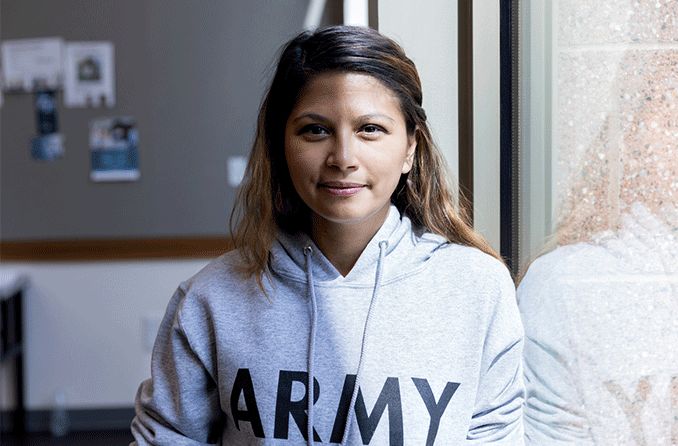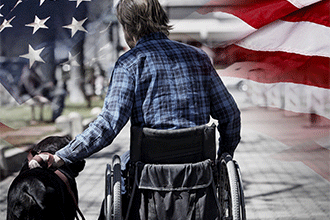Vision care for U.S. military veterans

Millions of U.S. military veterans served to protect this country. Now that they’re out of uniform, veterans — particularly those suffering from vision problems or advancing in age — need to be diligent about protecting their vision.
Thankfully, there are a number of options veterans can take advantage of to receive quality eye care.
Traditional vision care for military veterans
Veterans can take advantage of routine eye exams and vision testing. This includes exams for conditions like glaucoma. These tests and exams are part of health care benefits administered by the U.S. Department of Veterans Affairs (VA).

Vision appointments can be scheduled through a VA primary care provider or a VA medical center or clinic.
Also, many veterans qualify for free eyeglasses. This includes veterans with service-connected disabilities or veterans with conditions (such as stroke or diabetes) that a VA facility is treating.
Telehealth vision care options for veterans
More than 4.5 million veterans live in rural areas that are often far from the nearest VA facility. In 2015, to help those veterans, the VA launched the Technology-based Eye Care Services program, or TECS. As of 2020, the telehealth vision screening program operated at 22 VA health care facilities around the U.S.
TECS provides remote eye screening services to rural or underserved veterans who might otherwise run into trouble accessing eye exams or getting new glasses. The VA says TECS is not meant to replace in-person eye exams.
The program detects four vision problems commonly found in older veterans: diabetic retinopathy, glaucoma, macular degeneration and cataracts.
“Studies have shown that rural [veterans] are less likely to seek vision care if they live far from their health care providers or have travel barriers. Older rural [veterans] are also at greater risk of experiencing a blinding condition than their urban counterparts,” according to the VA.
Treatment for blindness or low vision
Veterans who are blind or have low vision should be able to get advanced vision care or rehabilitation services. According to the VA’s Center of Excellence for the Prevention and Treatment of Vision Loss, the VA logs about 5 million visits per year related to vision loss.
The VA operates 13 Blind Rehabilitation Centers across the country, as well as:
Intermediate and Advanced Low Vision Clinics: These locations offer vision care that goes beyond what’s provided at VA medical centers and clinics.
Vision Impairment Services in Outpatient Rehabilitation (VISOR) programs: VISOR programs provide short-term rehabilitation for people with blindness or vision problems.
Advanced Ambulatory Low Vision Clinics: These 23 clinics focus on vision skills and vision enhancement.
Visual Impairment Centers to Optimize Remaining Sight (VICTORS) program: The program’s three locations care for veterans experiencing substantial vision impairment.
Blind Rehabilitation Outpatient Specialist (BROS) program: This program teaches blind veterans at their homes or at VA medical centers.
Veterans Innovative Sight in Optometry Nexus (VISION) project: The VISION project strives to increase access to eye care and prevent blindness.
Guide dogs for U.S. veterans

The VA approves guide dogs for some blind and visually impaired veterans. Various non-government organizations accredited by Assistance Dogs International or the International Guide Dog Federation provide the dogs. The animals and the associated training are free. The VA also covers veterinary care and equipment for guide dogs.
Typically, a veteran’s primary care provider refers the patient to a specialist if it’s thought that a guide dog would be beneficial. A VA medical team then conducts an evaluation and may recommend acquisition of a guide dog.
VA counseling for the visually impaired
Some VA projects, such as the Vision Impairment Services Team and the VICTORS program, offer counseling to veterans who are visually impaired. Veterans can also seek help through the Veterans Crisis Line.
Vision research by the Veterans Administration
Veterans may not benefit immediately from the VA’s vision research. But they and other Americans may eventually be helped by innovations developed at the VA’s Center for Prevention and Treatment of Visual Loss.
The center, located in Iowa City, Iowa, focuses on the early detection of blinding disorders among veterans and the general population. These disorders include retinal disease, glaucoma and traumatic brain injury.
The center tests new ways of determining early signs of vision deterioration, examines how patients respond to treatment and develops new treatments.
In addition, vision research is a focus of the Vision Center of Excellence, joint-operated by the VA and the U.S. Department of Defense. Some of the research conducted at the center, located in Falls Church, Virginia, delves into traumatic brain injury and eye injuries sustained during explosions.
The Center for Visual and Neurocognitive Rehabilitation at the Atlanta VA Medical Center in Decatur, Georgia, is also a leader in the VA’s vision research. For instance, one research project there has explored ways to detect and treat eye disease that leads to blindness.
Eye issues affecting veterans
About 1.5 million veterans experience vision-threatening eye diseases, according to the Center for Prevention and Treatment of Vision Loss. These conditions include:

Diabetic retinopathy (976,000 veterans).
Glaucoma (285,000 veterans).
Age related macular degeneration (190,000 veterans).
Traumatic brain injury (20,000 veterans).
Not to mention, an estimated 130,000 veterans are legally blind.
Dr. Chris Lievens, an optometrist who’s chief of internal clinics at the Southern College of Optometry’s Eye Center in Memphis, Tennessee, says veterans of the Korean and Vietnam wars typically suffer from eye problems associated with old age. This includes conditions like age related macular degeneration.
On the other hand, younger veterans — those who served in Iraq and Afghanistan, for example — frequently cope with vision trouble caused by traumatic brain injury, Lievens says. In the past, veterans often died in blasts during armed conflict. Now, many are surviving these blasts, he says, but are winding up with concussions that can prompt vision problems.
In many cases, this type of injury is closed head trauma, meaning the head sustains an injury but the skull isn’t penetrated. Open head trauma occurs when an injury causes the skull to be broken. Traumatic brain injury can involve either closed head trauma or open head trauma.
“It’s a very difficult problem,” Lievens says of traumatic brain injury among veterans. “It’s something that is probably going to take many more years, if not decades, to solve.”
According to the Defense and Veterans Brain Injury Center, nearly 414,000 traumatic brain injuries were reported among U.S. servicemembers between 2000 and late 2019.
Lievens advises any veteran who has suffered a traumatic brain injury and is dealing with vision issues to “let your guard down” and seek help from an eye doctor.
“There is somebody out there for them who they can see that’s going to be willing to work with them to find a solution to their problem,” he says. “It’s probably not going to be easy. It may not happen right away. But there's someone out there who’s going to be willing to take a creative approach and ... help them out.”
READ MORE: Resources for visually impaired veterans
Annual eye exams essential to Veterans’ vision and eye health. U.S. Department of Veterans Affairs: Office of Public and Intergovernmental Affairs. August 2021.
VA vision care. U.S. Department of Veterans Affairs: Veterans Health Administration. April 2020.
Research improves tele-eye screenings for veterans. U.S. Department of Veterans Affairs: Office of Research and Development. February 2020.
About the center. U.S. Department of Veterans Affairs: Center for the Prevention and Treatment of Visual Loss. Accessed October 2021.
Guide and service dogs. U.S. Department of Veterans Affairs: Veterans Health Administration. March 2021.
Service dog veterinary health insurance benefit (VHIB) rules. U.S. Department of Veterans Affairs: Veterans Health Administration. November 2020.
Blind veterans. DAV. Accessed October 2021.
Department of Veterans Affairs (VA) resources. Vision Center of Excellence. Accessed October 2021.
Welcome to the Veterans Crisis Line. Veterans Crisis Line. Accessed October 2021.
VA Center for the Prevention and Treatment of Visual Loss. U.S. Department of Veterans Affairs: Center for the Prevention and Treatment of Visual Loss. Accessed October 2021.
Vision center of excellence promotes eye-injury research, care. U.S. Army. January 2012.
Vision research. Vision Center of Excellence. Accessed October 2021.
Focus on veterans’ vision: A glance at innovative vision research underway in Atlanta. VAntage Point. January 2017.
Atlanta VA health care center. U.S. Department of Veterans Affairs. Accessed October 2021.
CVNR highlights. Center for Visual and Neurocognitive Rehabilitation. Accessed October 2021.
Closed head injury. SCL Health. Accessed October 2021.
Traumatic brain injury. Johns Hopkins Medicine. Accessed October 2021.
Common classifications of TBI. American Speech-Language-Hearing Association (ASHA). Accessed October 2021.
VA research on traumatic brain injury (TBI). U.S. Department of Veterans Affairs: Office of Research and Development. Accessed October 2021.
Page published on Wednesday, October 27, 2021






